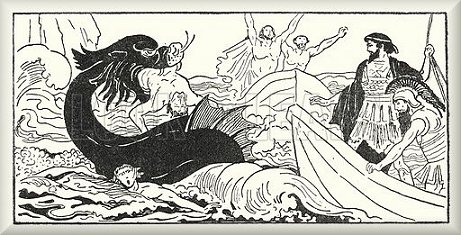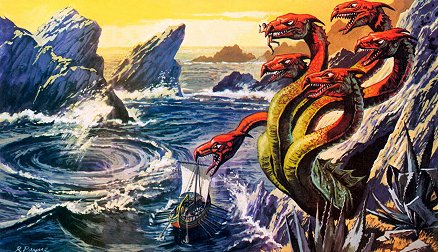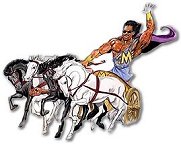|
SCYLLA & CHARYBDIS
Between Calabria, a region of Southern
Italy, and Sicily lies the Strait of Messina, said to be the
legendary home of the monster Scylla. On the opposite side of
the narrow channel of water lay her frightful counterpart named
Charybdis.
Scylla was described as a six-headed sea monster, or as a deadly
rock shoal, and Charybdis was an all-consuming whirlpool. Scylla
was found on the Calabrian side of the Strait of Messina, while
Charybdis occupied the coast of Sicily.
The two sides of the strait were but an arrow's range of each
other, so sailors trying to navigate the waters would have to
choose whether to pass dangerously close to Scylla, or instead
to take their chances by passing near Charybdis, risking
maritime death either way. The monsters were located close
enough to each other so trying to avoid one meant passing too
close to the other.
Hence to be "Between Scylla and Charybdis" has come to mean
having to decide between two similarly dangerous situations, or
to choose the lesser of two evils, and is seen as leading
inevitably to disaster.
When Odysseus, the hero of the Trojan War and the Odyssey had to
pass by the two monsters, he was advised by the sorceress Circe
to navigate close to Scylla and thus lose a few men, rather than
to pass by Charybdis and lose his entire ship and crew, which he
accomplished, choosing between the lesser of two evils.
"Hug Scylla's crag - sail on past her - top speed! Better by
far to lose six men and keep your ship than lose your entire
crew." Circe also instructed Odysseus to ask Scylla's mother,
the river nymph Crataeis, to prevent Scylla from striking more
than once.
Odysseus and his ship successfully navigated the strait of
Messina, but when they were momentarily distracted by Charybdis,
Scylla took the opportunity to snatch six of his sailors off the
deck and devour them alive.

At a later time Odysseus found himself stranded on a raft and
being swept back through the Strait of Messina, passing
perilously close to Charybdis. His raft was sucked into her
whirlpool, but he survived by managing to cling to a fig tree
that grew on a rock over her lair. When his raft was expelled on
the next outflow of water, Odysseus recovered it and paddled to
safety.
Jason and the Argonauts had to pass by Scylla and Charybdis
while on their quest to retrieve the Golden Fleece. Their patron
goddess, Hera, ordered the Nereid Thetis to help guide their
ship through the precarious passage.
Scylla's parentage is in question - her mother is said to be
Crataeis by some authors, while the father, if mentioned, is
either Poseidon, Lord of the Sea, his son Triton or Phorcys,
both sea gods. Yet others claim that Hecate and Apollo are her
parents. The monster Typhon and his hideous wife Echidna were
also said to be her parents, one of countless beasts they
birthed.
What was Scylla's origin? One myth says that Scylla was a
gorgeous and modest Naiad (a sea nymph) whom the lord of the
sea, Poseidon, saw and fell in love with. His wife Amphitrite
was having none of that. In a fit of jealous rage she poisoned
the water of the spring where Scylla bathed, turning the maiden
into a horrible monster.
Another version states that the beautiful Scylla was loved by a
man named Glaucus, a fisherman turned sea god. Scylla was
repulsed by his scaly form and fled to a promontory where
Glaucus could not follow.
Glaucus beseeched the sorceress Circe for a potion that would
make Scylla fall in love with him, but the enchantress herself
fell in love with him. But Glaucus wanted nothing to do with
Circe, being completely smitten by Scylla.
An enraged Circe waited until Scylla was bathing in the sea, and
then the jealous sorceress poured a malevolent potion into the
water. This caused Scylla to transform into the ghastly and
repulsive monster with six dog forms springing from her thighs,
each with a mouth with three rows of sharp teeth, sporting
twelve feet, and barking like a dog.
It is said that the greatest Greek hero, Heracles (Hercules) was
on a journey to Sicily and encountered Scylla. Heracles killed
the monster but her father, the sea god Phorcys, applied
flaming torches to her body and restored her to life.
The sea monster Charybdis was said to live under a small rock on
the Sicily side of the narrow Strait of Messina, across from
Scylla. Three times a day, Charybdis would swallow a huge amount
of water, and then would belch it back out. This would create
large whirlpools, easily capable of dragging ships underwater.
Sometimes Charybdis was described as just a whirlpool, rather
than a sea monster.
Some others say that Charybdis was the daughter of Poseidon and
Gaea (Mother Earth), and that she lived as a faithful servant to
her father. They claim that she aided her father Poseidon when
he was feuding with his brother Zeus, her paternal uncle. Scylla
helped Poseidon engulf lands and islands in water, taking them
away from Zeus.
Zeus was livid over the land she stole from him, and sent her to
the bottom of the sea with a thunderbolt. From the sea bed
Charybdis drank the water three times a day creating mighty
whirlpools and sending sailors to their watery graves.


BACK HOME

|







